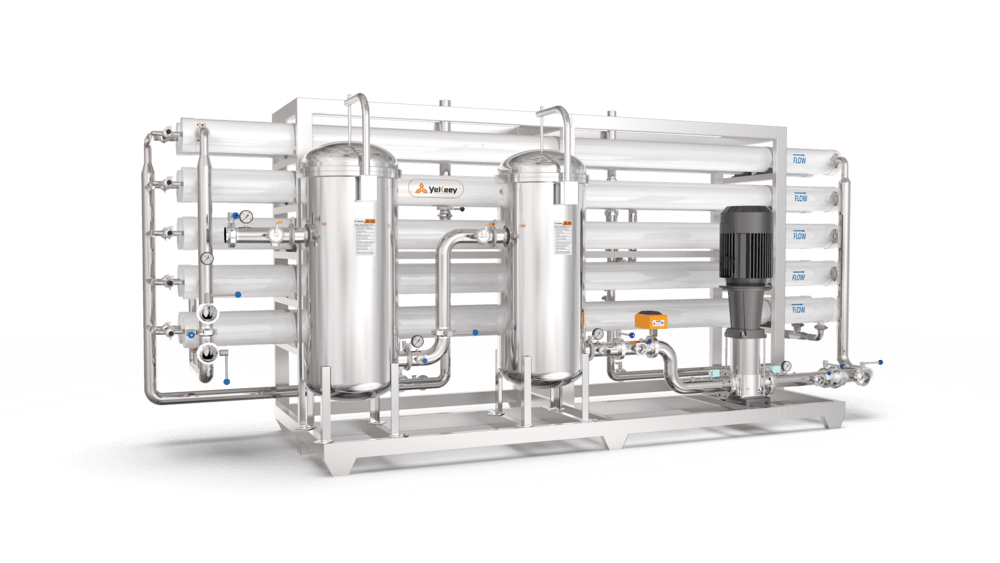Reverse Osmosis Explained
RO stands for Reverse Osmosis and refers to a method of water refinement that makes use of a semi-permeable membrane to remove impurities, substances, and dissolved salts from water. Different from the usual filtering methods, RO works by using the force of pressure to overcome osmotic pressure which squeezes the molecules of water through the membrane while leaving contaminants behind. On one side is highly purified water, while on the other is concentrated pollutants as a result of the selective permeation process.
Parts of an RO Water Treatment System
An RO system consists of several essential components which play different roles in this purification process. These are:
Pretreatment: Before it enters into RO membranes, water undergoes pretreatment to remove big particles, sediments, and chlorine. It ensures prolonged service life and prevents damage to delicate RO membranes.
Ro Membrane: This is where all waters are purified during the filtration process. It contains tiny apertures that allow only the passage of pure H2O molecules whereas bacteria, viruses, heavy metals, or dissolved salts remain blocked.
Pressure Pump: To break down osmotic pressure to facilitate flow across the membrane in a reverse osmosis system there is a need for such pumps. They monitor optimal levels which ensure maximum purifications possible.
Post Filtration: After going through the membrane post filters are used to further polish quality. Normally activated carbon filters are used inside these steps to remove any remaining smell taste or contaminants still present thus improving overall water purity.
Benefits of Using Reverse Osmosis Water Treatment Systems
Adopting RO water treatment equipment offers numerous benefits both for households and industries. Some of them include;
Quality Water: Ro systems can eliminate an extensive range of unwanted matters like heavy metals, chemicals in addition to microbes as well as dissolved solids hence making it meet strict criteria for purity standards.
Health Improvement and Protection: It offers us cleaner drinking liquid. It removes all noxious pollutants and microorganisms. This reduces the danger of waterborne ailments.
Eco-Friendly: About bottled water or other conventional treatments, ro systems are energy conservative and have less waste thus eco-friendly for water purification.
Affordability: RO systems are initially expensive, but the money saved in terms of buying bottled water in the future outweighs the cost of purchasing them in addition to their maintenance making it a good idea for people who want to save some amount of money.
Applications of Reverse Osmosis Water Treatment Systems
Water treatment applications that employ RO technology are present in many sectors and cater to various needs. A few examples include;
Home Water Purification: To make sure that drinking water is clean at home, households go for reverse osmosis systems. Under-the-sink or countertop models can be found to provide access points to treated water within homes for cooking, drinking, and other uses.
Commercial & Industrial Processes: It is impossible to have quality processed water during the manufacturing of food beverages or drugs without using RO systems. These industries require the use of RO machines because they help them meet the set standards by enhancing product value while at the same time reducing contamination risks.
Municipal Water Treatment Plant Use: Urban areas often purify groundwater/surface sources meant for public consumption using better methods like large-scale RO as used by municipal treatment plants. Municipalities are adopting this system since it helps them comply with drinking water regulations currently being put into place and addresses concerns regarding the scarcity and quality of this resource.
Wastewater Recycling: The use of RO membranes is crucial for treating wastewater and recycling processes to regain usable resources from wastewater such as freshwater, nutrients, and energy. It is a sustainable approach that helps to preserve water resources and minimize environmental pollution.
Challenges and Future Developments
However, the equipment used in RO water treatment has its challenges despite having many positive impacts. Common problems include membrane fouling, high energy requirements, and brine wastewater generation. These issues require continuous research and innovation aimed at enhancing membrane performance, developing processes that consume less power, as well as optimizing waste disposal techniques.
Going forward, there are promising advancements in membrane materials, system designs, and their incorporation into renewable energy sources. Emerging trends like osmosis forwards; distillation across membranes; and nanotechnology could offer exciting ways to improve the efficiency of RO water treatment machines about affordability, sustainability as well and performance making the world a cleaner healthier place with enough water for everyone.

